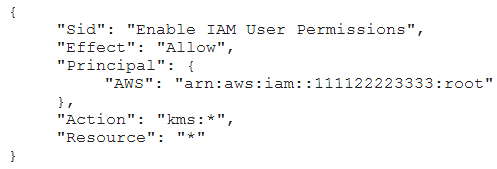- (Exam Topic 2)
A Software Engineer is trying to figure out why network connectivity to an Amazon EC2 instance does not appear to be working correctly. Its security group allows inbound HTTP traffic from 0.0.0.0/0, and the outbound rules have not been modified from the default. A custom network ACL associated with its subnet allows inbound HTTP traffic from 0.0.0.0/0 and has no outbound rules.
What would resolve the connectivity issue?
Correct Answer:
C
https://docs.aws.amazon.com/vpc/latest/userguide/vpc-network-acls.html
- (Exam Topic 1)
A Security Engineer accidentally deleted the imported key material in an AWS KMS CMK. What should the Security Engineer do to restore the deleted key material?
Correct Answer:
C
- (Exam Topic 2)
A Security Engineer who was reviewing AWS Key Management Service (AWS KMS) key policies found this statement in each key policy in the company AWS account.
What does the statement allow?
Correct Answer:
D
- (Exam Topic 1)
Users report intermittent availability of a web application hosted on AWS. Monitoring systems report an excess of abnormal network traffic followed by high CPU utilization on the application web tier. Which of the following techniques will improve the availability of the application? (Select TWO.)
Correct Answer:
BD
- (Exam Topic 3)
A company requires that data stored in AWS be encrypted at rest. Which of the following approaches achieve this requirement? Select 2 answers from the options given below.
Please select:
Correct Answer:
BE
The AWS Documentation mentions the following
To create an encrypted Amazon EBS volume, select the appropriate box in the Amazon EBS section of the Amazon EC2 console. You can use a custom customer master key (CMK) by choosing one from the list that appears below the encryption box. If you do not specify a custom CMK, Amazon EBS uses the
AWS-managed CMK for Amazon EBS in your account. If there is no AWS-managed CMK for Amazon EBS in your account, Amazon EBS creates one.
Data protection refers to protecting data while in-transit (as it travels to and from Amazon S3) and at rest (while it is stored on disks in Amazon S3 data centers). You can protect data in transit by using SSL or by using client-side encryption. You have the following options of protecting data at rest in Amazon S3.
• Use Server-Side Encryption - You request Amazon S3 to encrypt your object before saving it on disks in its data centers and decrypt it when you download the objects.
• Use Client-Side Encryption - You can encrypt data client-side and upload the encrypted data to Amazon S3. In this case, you manage the encryption process, the encryption keys, and related tools.
Option A is invalid because using EBS-optimized Amazon EC2 instances alone will not guarantee protection of instances at rest. Option C is invalid because this will not encrypt data at rest for S3 objects. Option D is invalid because you don't store data in Instance store. For more information on EBS encryption, please visit the below URL:
https://docs.aws.amazon.com/kms/latest/developerguide/services-ebs.html For more information on S3 encryption, please visit the below URL: https://docs.aws.amazon.com/AmazonS3/latest/dev/UsinEEncryption.html
The correct answers are: When storing data in EBS, encrypt the volume by using AWS KMS. When storing data in S3, enable server-side encryption.
Submit your Feedback/Queries to our Experts

